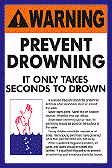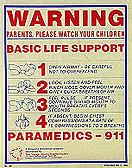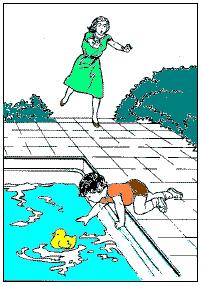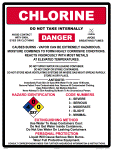 | Consumer Product Safety CommissionBACKYARD POOL:
Always Supervise Children
Safety Commission Warns |
 |
According to the U.S. Consumer Product Safety Commission, an estimated 350 children under five years of age drown each year in swimming pools, many in residential pools. The Commission estimates that another 2,600 children under age five are treated in hospital emergency rooms each year following submersion incidents. Some of these submersions result in permanent brain damage.
Nationally, drowning is a leading cause of death to children under five.
The key to preventing these tragedies is to have layers of protection. This includes placing barriers around your pool to prevent access, using pool alarms, closely supervising your child and being prepared in case of an emergency. CPSC offers these tips to prevent drowning:

- Fences and walls should be at least 4 feet high and installed completely around the pool. Fence gates should be self-closing and self-latching. The latch should be out of a small child's reach.
- If your house forms one side of the barrier to the pool, then doors leading from the house to the pool should be protected with alarms that produce a sound when a door is unexpectedly opened.
|
- A power safety cover -- a motor-powered barrier that can be placed over the water area -- can be used when the pool is not in use.
- Keep rescue equipment by the pool and be sure a portable phone is poolside with emergency numbers posted. Knowing cardiopulmonary resuscitation (CPR) can be a lifesaver.
- For above-ground pools, steps and ladders to the pool should be secured and locked or removed when the pool is not in use.
- If a child is missing, always look in the pool first. Seconds count in preventing death or disability.
- Pool alarms can be used as an added precaution. Underwater pool alarms generally perform better and can be used in conjunction with pool covers. CPSC advises that consumers use remote alarm receivers so the alarm can be heard inside the house or in other places away from the pool area.
PARENTS AND GUARDIANS: ONLY YOU CAN PREVENT A DROWNING. WATCH YOUR CHILD CLOSELY AT ALL TIMES. MAKE SURE DOORS LEADING TO THE POOL AREA ARE CLOSED AND LOCKED. YOUNG CHILDREN CAN QUICKLY SLIP AWAY AND INTO THE POOL.
|
THE CONSUMER PRODUCT SAFETY COMMISSION CAUTIONS DIVERS ABOUT IMPROPER DIVING PRACTICES
Diving injuries can result in quadriplegia, paralysis below the neck, to divers who hit the bottom or side of a swimming pool, according to CPSC. Divers should observe the following precautions:
- Never dive into above-ground pools. They are too shallow.
- Don't dive from the side of an in-ground pool. Enter the water feet first.
- Dive only from the end of the diving board and not from the sides.
- Dive with your hands in front of you and always steer up immediately upon entering the water to avoid hitting the bottom or sides of the pool.
- Don't dive if you have been using alcohol or drugs because your reaction time may be too slow.
Improper use of pool slides presents the same danger as improper diving techniques. Never slide down head first - slide down feet first only.
|
Following are just a few facts uncovered by the U.S. Consumer Product Safety Commission (CPSC) in a comprehensive study of drowning and submersion incidents
involving children under 5 years old in Arizona, California, and Florida.
- Seventy-five percent of the submersion victims studied by CPSC were between I and 3
years old; 65 percent of this group were boys. Toddlers, in particular, often do something
unexpected because their capabilities change daily.
- At the time of the incidents, most victims were being supervised by one or both parents.
Forty-six percent of the victims were last seen in the house; 23 percent were last seen in
the yard or on the porch or patio; and 31 percent were in or around the pool before the
accident. In all, 69 percent of the children were not expected to be at or in the pool,
yet they were found in the water.
- Submersion incidents involving children usually happen in familiar surroundings.
Sixty-five percent of the incidents happened in a pool owned by the child's family and 33
percent o the incidents happened in a pool owned by friends or relatives.
- Pool submersions involving children happen quickly. A child can drown in the time it
takes to answer a phone. Seventy-seven percent of the victims had been missing from sight
for 5 minutes or less.
- Survival depends on rescuing the child quickly and restarting the breathing process,
even while the child is still in the water. Seconds count in preventing death or brain
damage.
- Child drowning is a silent death. There's no splashing to alert anyone that the child is
in trouble.
NSPI statistics show that drowning and swimming accidents are best prevented by adult supervision, public awareness programs including water safety training for young children, and not drinking alcohol while swimming, diving or soaking. Statistically, most accidents involving drowning or severe injury occur to children under 5 years of age who are unsupervised, cannot swim, and fall into a pool or pool cover with water on top. Toddlers at the age of 2 or 3 are most likely to wander off from a parent's supervision. Barriers such as fences or back doors are often left unlocked. Drowning is NOT accompanied by loud noise or splashing sounds. DROWNING IS SILENT! To prevent child drowning, there is NO substitute for parental supervision.
The second largest number of accidental injuries occur to teenagers, primarily males. Often the victim has been drinking alcohol and has dove into the pool in an area too shallow for diving, or from a location not intended for diving (like the roof of the house). Many of those who "drink and dive" end up in a wheelchair, if they're lucky. Alcohol and spas are also a potentially lethal combination; the hot water and the alcohol combine to cause individuals to fall asleep and drown in only three feet of water.
In some areas of the nation's sunbelt, drowning has been the leading cause of accidental death in the home of children under 5 years old. The information below can help parents and caregivers provide young children with the protection they deserve.
Each year, nationwide, more than 300 children under 5 years old drown in residential swimming pools, usually a pool owned by their family. In addition, more than 2,000 children in that age group are treated in hospital emergency rooms for submersion injures.
Many communities have enacted safety regulations governing residential swimming pools -- inground and aboveground. It's up to parents to comply with these regulations. Apart from these laws, parents who own pools, can take their own precautions to reduce the chances of their youngsters accessing the family pool or spa without adult supervision.
NSPI Drowning Prevention Tips:
- There is NO substitute for adequate supervision. The
"buddy system" of two children, is no substitute. Even people that can swim,
very well, can drown when they bump their head, become entrapped, or have medical
emergencies like seizures or black outs. DON'T LET THEM OUT OF YOUR SIGHT!
- Pools and spas are attractive to children; what the court calls an
"attractive nuisance". There must be a permanent barrier to entry. Local
ordinances will specify a 3 - sided or a 4 - sided, non-climbable fence with self-closing,
self-latching mechanisms on the gate. The gate should be locked when the pool is not in
use. Do not place chairs or tables near a fence which would allow a child to climb over.
Portable, above ground spas should have a hard top that locks on, preventing its use.
- In addition to a barrier around the pool, NSPI promotes an idea called Layers of
Protection, and has produced a pamphlet under the same name. This is the combination of
many safety features working together to form several "layers" of safety
protection around a swimming pool or spa. A simple fence just won't do to protect the pool
when it is not under supervision. Door exit alarms, infrared detectors or security
cameras. Pool alarms, child alarms, or pool safety covers will all help to prevent
accidents.
- Ensure that the pool is in clear view from the house, and not obstructed by
plants, canopies, solid fences, or darkness. This is not so that you can watch your
swimmers from the house; rather to ensure that the pool is not in use when it is not
supposed to be.
- Place a phone nearby the pool with emergency numbers (911) listed. Signage about
the pool, with "pool rules" is a good idea, but remember to always instruct new
users of your pool to what is allowed and what is not. Having a pool can make you popular
with neighborhood friends of your children. If rules are not followed, do not allow these
children to use the pool.
- Having rescue equipment on hand can help prevent a drowning person from drowning
someone else. Ring buoys & reaching poles should be at the ready. First aid kits
should be nearby also.
- If you use a pool or spa cover, follow all instructions for their safe
installation, use and maintenance. Always remove a cover completely before using the pool,
and do not let standing water remain on top; pump it off.
- Do not allow children to play near a pool. Games and bike riding can result in
someone going in, perhaps bumping their head on the way.
- Learn CPR (Cardio-Pulmonary Resuscitation).
- Have your children take swimming lessons at an early age.
Use of Diving Boards:
- If the diving board bothers you, have it removed. If it is too large for the
length and depth of the pool; found on many older pools, have it removed.
- Inspect the board, the stand, and the hardware for signs of age, cracking, rust,
etc.
- Do Not allow any drinking and diving. Place a chair on top of the board, with a
"No Diving" sign during pool parties.
- Follow the manufacturer's instructions on safe diving practices, or consult
NSPI's pamphlet "Knowing how to dive can be worth more than gold". Instruct all
users of your diving board on proper technique.
Chemical Safety practices are important to prevent accidents during the transportation, use and
storage of pool chemicals. |  |
Transporting Chemicals:
- Keep your vehicle clean and organized.
- Separate incompatible chemicals, distribute between front seat, back seat and /
or trunk.
- Don't purchase or carry damaged containers.
- Anchor your load securely, so that it won't move around.
- Ask your pool supply dealer for MSDS sheets, for your information and HAZMAT
personnel in case of an accident.
Storing Pool Chemicals:
- Store chemicals in a cool, dry, well ventilated area, with a locked entry. Do
not set outside in the sun.
- Keep out of reach of children.
- Keep pool and spa chemicals separate from each other, and from other chemicals. Violent
reactions such as explosion, fire or noxious gas production can occur when
incompatible chemicals contact each other. Never, ever mix any chemicals together.
- Do not stack chemical containers on top of one another.
- Replace lids and caps firmly and immediately after opening.
- Post MSDS sheets and emergency information and phone numbers nearby.
Using Pool Chemicals:
- Follow label directions carefully. Read the instructions! If the label is faded
or torn, don't guess what it is. Return it to your dealer.
- Add chemicals to pool water, not the other way around. Chemicals should be added
directly to the pool, or through a feeder especially designed for that type of chemical.
Chemicals added directly to the skimmer could allow strong concentrations to harm pool
equipment or swimmers. If the instructions suggest diluting with water first, use a clean,
oversized bucket with water in it, then add chemicals to the water in the bucket. Read the
Instructions!
- Wear safety gear when handling chemicals. This may include a breathing
respirator to prevent inhalation of fumes, face shield, gloves and apron.
- Do Not mix chemicals...EVER! This includes direct mixing of full strength
chemicals in a bucket, diluted concentrations and even adding chemicals to the same
location in the pool. At the very least you may get a water quality problem, or you may
endanger your life or the life of others. Chemicals can mix with each other by using
containers or scoops which were previously used for other chemicals. Always use a clean
bucket and scoop, designated only for that chemical.
- Dispose of wastes and spills safely and properly. Immediately clean up any
chemical spills. If a violent reaction has occurred, contact the fire department
immediately and they will instruct you on steps to take until their arrival, if any. If
the spilled chemical is a solid, carefully sweep it up using a clean broom and shovel, and
place it in a clean, dry, plastic container. Avoid breathing the dust. If possible, dilute
the chemical in water and add it to the pool or spa. Then test and balance the water. If
this is not possible, contact the fire department for instructions on disposal. Do not
place floor sweepings of chemicals back into the original container. Any foreign substance
such as dust, dirt, water can cause a reaction inside the container. Do not use a vacuum
cleaner or shop vac to clean up spilled substances. If the spilled substance is a liquid,
it should be soaked up with clean, absorbent materials and placed inside a clean plastic
or plastic lined container. Flush the area with large amounts of water.
- Never smoke around any chemicals. Fire or explosion could result.
- Do not breath chemical fumes or dust. Wash skin if contact occurs. If chemicals
splash in eyes, flush eyes for 15 minutes, and see a physician immediately.
- Use ONLY a water filled fire extinguisher on a chlorine chemical fire. Never use
the dry chemical type of extinguisher.
- Keep posted emergency numbers for the fire department, poison control center,
and MSDS sheets of all chemicals on hand.
|








